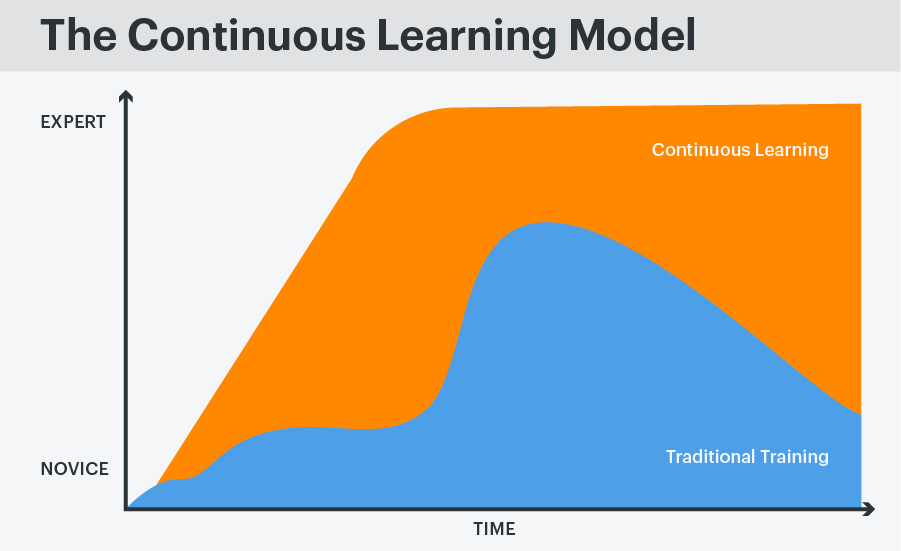Continuous learning is a workplace mindset that encourages employees to prioritize ongoing learning and improvement. Examples include various formats, such as online workshops or courses, training modules, and shadowing/coaching opportunities. According to LinkedIn’s 2023 Workplace Learning Report, 89% of learning and development (L&D) professionals believe that developing employee skills supports navigating the evolving future of work. Providing these opportunities is a critical initiative, especially for workforce management organizations. Providing professional development opportunities minimizes employee burnout, resulting in heightened employee satisfaction and improved employee retention, driving the success of the company.
The Impact
Continuous learning allows employees to expand their knowledge of various company initiatives and further professional development. While continuous learning is a great initiative for all organizations, workforce management organizations can instill the advantage of these opportunities into the clients they serve. Effective workforce management is not transactional; it revolves around effective hiring and retention strategies. Continuous learning initiatives provide employees with a resource for additional mentorship and professional development opportunities. Here are some of the benefits continuous learning provides:
Increased Productivity
As processes evolve, employees should continuously refine their skills to ensure tasks are performed efficiently and effectively. Continuous learning initiatives better prepare employees to embrace change with resilience, ensuring consistent productivity.
Career Development
Mentorship and shadowing workshops grant employees the opportunity to network and learn from leaders within the company. Through this initiative, employees can gain insight into the career path at their organization and what skills can be developed to promote within the company. Employees equipped with professionalism, time management, and prioritization techniques allocate time efficiently and are highly valued in the workplace.
Certification Opportunities
Through networking and leadership summits, employees can discover new certification programs that will set them up for success in developing their careers. Many certifying organizations, such as HubSpot, LinkedIn Learning, and Grow with Google, provide lists of continuing education programs, which can help you select a program that fits your schedule and expands your skills.
Job Satisfaction
Employees engaged in continuous learning tend to be more motivated. When they see their efforts toward learning and development being valued by the company, they become more committed to their work. Employers often prefer to have team members who are passionate about their work, so they may offer a range of professional enrichment opportunities.

Common Types of Continuous Learning
To promote a continuous learning environment within an organization, using different formats and methodologies caters to a wider range of learning styles. These methodologies can include structured learning, social learning, and self-directed learning.
Structured Learning
Structured learning is a formal method typically held at a specific place and time. In the workforce, structured learning typically comes in the form of online training courses, workshops, and webinars.
Social Learning
Social learning initiatives happen more informally and through collaborative efforts. This may include mentorship efforts, discussions, brainstorming sessions, and collaborative problem-solving.
Self-Directed Learning
Self-directed learning provides an opportunity for employees to complete training modules at their own pace. Here employees discover what they’re most interested in, which helps improve the adoption of continuous learning.
Implementation of Continuous Learning
Promoting continuous learning in the workplace starts with business leadership by emphasizing the value of L&D. Once the L&D team is formed, a learning infrastructure is developed. This involves leveraging user-friendly learning management software, such as WorkRamp, where employees have access to a variety of learning modules geared towards professional development. Providing mandatory structured learning modules, such as security training, through the designated learning management software is a great way to familiarize employees with the platform and encourages continued use of the learning modules. For continuous learning to be effective, it needs to be an ongoing initiative. The L&D team should foster a collaborative environment where knowledge is shared, promoting a culture of continuous improvement.
“First and foremost, collaboration is key. You want learners to be part of the journey. They’re going to show you where you need to go, and your champions are going to help you along the way. That’s been a huge part of this.”
– Andrea Burow, Knowledge Services L&D Partner
To learn more about how we can assist your organization in workforce management, contact us today.





